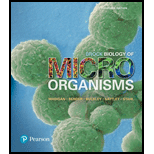
Enteric bacteria, lactic acid bacteria, and propionic acid bacteria have distinctive
To describe:
The metabolic characteristics of enteric bacteria, propionic acid bacteria, and lactic acid bacteria, name a genus that belongs to each group, and indicate by what means these organisms can be distinguished.
Concept introduction:
The order Lactobacillales comprised of fermentative organisms such as lactic acid bacteria. The lactic acid bacteria generate lactic acid as the end-product after the fermentation process. Enteric acid bacteria are bacteria usually resides in the intestine of humans and animals. The enteric bacteria play an important role in digestion of their hosts. The propionic acid bacteria reside in the sweat glands of the human and it is also present in the stomach of the ruminants.
Explanation of Solution
Enteric bacteria, for example species of Escherichia are facultative anaerobes. They inhabit the gastrointestinal tract of humans and warm-blooded animals, where they characteristically grow chemoorganotrophically by means of fermentation. They live in a wide range of substrates. Under anaerobic conditions they use mixed-acid fermentation generating succinate, acetate, ethanol, and lactate.
Lactic acid bacteria, for example species of Lactobacillus are aerotolerant, anaerobes. During fermentative metabolism, they yield lactate as the major product, in which energy is produced by substrate-level phosphorylation. The lactic acid bacteria have restricted biosynthetic abilities and characteristically have complex nutritional necessities such as amino acids, vitamins, purines, and pyrimidines.
Propionic acid bacteria are fermentative bacteria, for example species of Propionibacterium. They commonly establish in the sweat glands of humans and the stomachs of ruminants. The propionic acid bacteria generate acetic acid, propionic acid, and Co2 as products of anaerobic metabolism. Lactate is the major substrate for propionic acid bacteria, which is already a fermentation product. Therefore, propionic acid bacteria carry out secondary fermentation by fermenting the previous product of fermentation.
Want to see more full solutions like this?
Chapter 16 Solutions
Brock Biology of Microorganisms (15th Edition)
- What is this?arrow_forwardMolecular Biology A-C components of the question are corresponding to attached image labeled 1. D component of the question is corresponding to attached image labeled 2. For a eukaryotic mRNA, the sequences is as follows where AUGrepresents the start codon, the yellow is the Kozak sequence and (XXX) just represents any codonfor an amino acid (no stop codons here). G-cap and polyA tail are not shown A. How long is the peptide produced?B. What is the function (a sentence) of the UAA highlighted in blue?C. If the sequence highlighted in blue were changed from UAA to UAG, how would that affecttranslation? D. (1) The sequence highlighted in yellow above is moved to a new position indicated below. Howwould that affect translation? (2) How long would be the protein produced from this new mRNA? Thank youarrow_forwardMolecular Biology Question Explain why the cell doesn’t need 61 tRNAs (one for each codon). Please help. Thank youarrow_forward
- Molecular Biology You discover a disease causing mutation (indicated by the arrow) that alters splicing of its mRNA. This mutation (a base substitution in the splicing sequence) eliminates a 3’ splice site resulting in the inclusion of the second intron (I2) in the final mRNA. We are going to pretend that this intron is short having only 15 nucleotides (most introns are much longer so this is just to make things simple) with the following sequence shown below in bold. The ( ) indicate the reading frames in the exons; the included intron 2 sequences are in bold. A. Would you expected this change to be harmful? ExplainB. If you were to do gene therapy to fix this problem, briefly explain what type of gene therapy youwould use to correct this. Please help. Thank youarrow_forwardMolecular Biology Question Please help. Thank you Explain what is meant by the term “defective virus.” Explain how a defective virus is able to replicate.arrow_forwardMolecular Biology Explain why changing the codon GGG to GGA should not be harmful. Please help . Thank youarrow_forward
- Stage Percent Time in Hours Interphase .60 14.4 Prophase .20 4.8 Metaphase .10 2.4 Anaphase .06 1.44 Telophase .03 .72 Cytukinesis .01 .24 Can you summarize the results in the chart and explain which phases are faster and why the slower ones are slow?arrow_forwardCan you circle a cell in the different stages of mitosis? 1.prophase 2.metaphase 3.anaphase 4.telophase 5.cytokinesisarrow_forwardWhich microbe does not live part of its lifecycle outside humans? A. Toxoplasma gondii B. Cytomegalovirus C. Francisella tularensis D. Plasmodium falciparum explain your answer thoroughly.arrow_forward
- Select all of the following that the ablation (knockout) or ectopoic expression (gain of function) of Hox can contribute to. Another set of wings in the fruit fly, duplication of fingernails, ectopic ears in mice, excess feathers in duck/quail chimeras, and homeosis of segment 2 to jaw in Hox2a mutantsarrow_forwardSelect all of the following that changes in the MC1R gene can lead to: Changes in spots/stripes in lizards, changes in coat coloration in mice, ectopic ear formation in Siberian hamsters, and red hair in humansarrow_forwardPleiotropic genes are genes that (blank) Cause a swapping of organs/structures, are the result of duplicated sets of chromosomes, never produce protein products, and have more than one purpose/functionarrow_forward
 Biology (MindTap Course List)BiologyISBN:9781337392938Author:Eldra Solomon, Charles Martin, Diana W. Martin, Linda R. BergPublisher:Cengage Learning
Biology (MindTap Course List)BiologyISBN:9781337392938Author:Eldra Solomon, Charles Martin, Diana W. Martin, Linda R. BergPublisher:Cengage Learning Biology Today and Tomorrow without Physiology (Mi...BiologyISBN:9781305117396Author:Cecie Starr, Christine Evers, Lisa StarrPublisher:Cengage Learning
Biology Today and Tomorrow without Physiology (Mi...BiologyISBN:9781305117396Author:Cecie Starr, Christine Evers, Lisa StarrPublisher:Cengage Learning Comprehensive Medical Assisting: Administrative a...NursingISBN:9781305964792Author:Wilburta Q. Lindh, Carol D. Tamparo, Barbara M. Dahl, Julie Morris, Cindy CorreaPublisher:Cengage Learning
Comprehensive Medical Assisting: Administrative a...NursingISBN:9781305964792Author:Wilburta Q. Lindh, Carol D. Tamparo, Barbara M. Dahl, Julie Morris, Cindy CorreaPublisher:Cengage Learning





